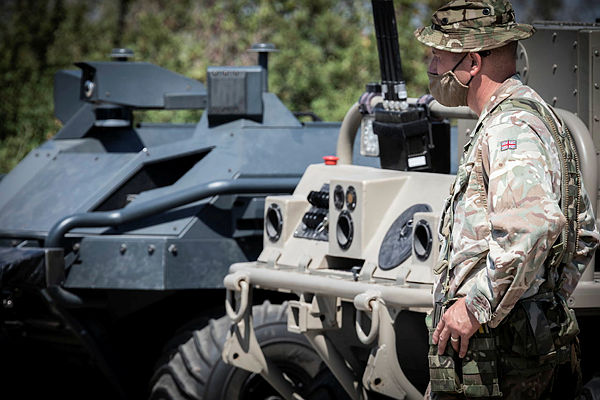When considering communication protocols for cross-platform communications and control of autonomous platforms in defense applications on the battlefield, several factors need to be taken into account. Key considerations include reliability, latency, security, scalability, and interoperability. Here, I’ll provide a comparison of some commonly used communication protocols and evaluate their applicability in this context:
Message Queuing Telemetry Transport (MQTT):
- MQTT is a lightweight publish-subscribe protocol designed for constrained devices and low-bandwidth, high-latency networks.
- It provides a simple and efficient way to distribute messages among multiple devices using a broker.
- MQTT’s low overhead makes it suitable for resource-limited autonomous platforms, but it may not be ideal for scenarios requiring high-speed real-time control due to its reliance on a centralized broker.
Extensible Messaging and Presence Protocol (XMPP):
- XMPP is an open-standard communication protocol primarily used for instant messaging and presence information.
- It enables real-time messaging and supports various extensions for additional functionalities.
- XMPP offers strong security features and good interoperability but may not be the best choice for high-performance control applications due to its focus on messaging and presence rather than low-latency communication.
Data Distribution Service (DDS):
- DDS is a middleware protocol specifically designed for real-time, high-performance, and scalable data sharing.
- It uses a decentralized publish-subscribe model with a data-centric approach.
- DDS provides low latency, reliable data delivery, and supports Quality of Service (QoS) mechanisms for prioritization and data filtering.
- DDS is well-suited for autonomous platforms in defense applications that require real-time control, data synchronization, and scalability. It is widely used in mission-critical systems.
Advanced Message Queuing Protocol (AMQP):
- AMQP is an open-standard messaging protocol that provides reliable, message-oriented communication.
- It supports both publish-subscribe and point-to-point messaging patterns.
- AMQP offers features such as message acknowledgement, queuing, and routing, making it suitable for reliable and secure communications.
- While AMQP can be used for cross-platform communication, it may not be as performant as DDS in terms of latency and scalability for control of autonomous platforms.
Internet Protocol Suite (TCP/IP):
- TCP/IP is the foundational protocol suite of the internet, providing reliable, connection-oriented communication.
- It offers a wide range of protocols, including TCP (Transmission Control Protocol) and UDP (User Datagram Protocol).
- TCP/IP is highly interoperable and widely supported, making it a good choice for cross-platform communications. However, TCP/IP may not be the best option for real-time control due to potential latency and the need for additional protocols or mechanisms to handle reliability and synchronization.
gRPC
- gRPC is a high-performance, open-source framework developed by Google for remote procedure calls (RPC) across different platforms and languages.
- It uses the Protocol Buffers (protobuf) serialization format for efficient and compact data transfer.
- gRPC supports bidirectional streaming, flow control, and authentication mechanisms.
- It provides strong support for load balancing and service discovery.
- gRPC offers excellent performance, low latency, and scalability, making it suitable for cross-platform communication in autonomous platforms.
- However, gRPC may require additional security mechanisms for defense applications due to the sensitivity of data being transmitted.
Representational State Transfer (REST)
- REST is an architectural style that uses the HTTP protocol for communication between systems. It is based on a client-server model where clients send requests to servers, and servers respond with the requested data.
- RESTful APIs provide a standardized way to interact with resources over the web using HTTP methods such as GET, POST, PUT, and DELETE. REST is widely adopted, simple to implement, and supports stateless communication.
- It offers good interoperability and scalability, making it suitable for cross-platform communications in defense applications. However, REST may not provide the same level of real-time capabilities as some other protocols mentioned in this article.
Conclusion
Considering the requirements for control of autonomous platforms in defense applications, DDS appears to be the most suitable protocol. It offers low-latency, real-time communication, reliability, scalability, and a robust set of QoS mechanisms. However, the final choice should consider specific use cases, system constraints, and interoperability requirements within the defense application environment.
DDS is already widely used in Generic Vehicle Architecture (GVA) enabled land vehicles and autonomous cars, where it facilitates the exchange of sensor data, control commands, and situational awareness information. It’s also the communications bus underpinning Robot Operating System (ROS2).
The same underlying principles that make DDS suitable for vehicle architectures can be extended to cover autonomous drones. Drones require similar capabilities for coordination, communication, and situational awareness, making DDS an excellent choice for their control and swarming capabilities.
Updated:
Over on LinkedIn there were expressed some concerns regarding the mixed message formats, transport protocols, security, and latency considerations in the context of radio communications for autonomous systems. Let’s address your points one by one:
- Mixed message formats and transport protocols: It’s true that there can be various message formats and transport protocols used in autonomous systems, including TCP/IP and UDP. The choice of format and protocol depends on the specific requirements and constraints of the system. While the article might have presented a mix of formats, it’s important to select the appropriate combination that suits the given application.
- Security: If you are using a commercial off-the-shelf (COTS) radio that supports TCP/IP and UDP, the security measures can be implemented at the radio stack level. In such cases, additional security measures at the message format level might be redundant. However, it’s worth noting that security is a critical aspect in any communication system, and it’s always advisable to implement multiple layers of security to ensure robust protection against potential threats.
- Latency on RF networks: RF networks can introduce latency due to factors like signal propagation, interference, and network congestion. Achieving near real-time communication can indeed be challenging in RF networks. When designing autonomous systems, it is crucial to consider these latency limitations and build mechanisms to handle delayed or intermittent communication. The suggestion of having a decision tree, such as the Primary, Alternate, Contingent, and Emergency (PACE) model, is a valuable approach to ensure system functionality in various communication scenarios.
A recommendation to start with RF considerations and design the system accordingly is a prudent approach. Understanding the limitations and uncertainties of wireless communication in autonomous systems is vital to ensure reliable operation even in challenging environments.
If you would like to further discuss this topic or require additional information, please feel to reach out on LinkedIn.



